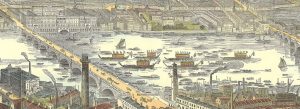Hi, I’m Laura, a third year History and Archaeology student and this will be my second year at the Digital Humanities Lab as an intern. My interests span 2D digitisation to 3D digitisation techniques such as RTI (Reflectance Transformation Imaging) and photogrammetry. I love how these techniques are applied to cultural heritage and wider research questions within the subjects I study. For this blog post, I am going to combine my love for 3D techniques and GIS (Geographic Information Systems). In my first year at Exeter, I attended an archaeology lecture given by Prof. Leif Isaksen (Director of the DH Lab) about the dig he directed at Cluny Hill, Scotland. He passed around a printed 3D model that showcased the topography of the land. It was the first time I had seen anything like it- the fact that you could almost picture the landscape and see the contours of it despite not being physically on location excited me. In fact, it started an obsession with landscape data and my love for its link to material culture within archaeology! And another with Digital Humanities! Continue reading
Monthly Archives: June 2021
Digitisation of Smyth’s 1845 ‘Panorama of London’
We are delighted to present an interactive map of the print of Smyth’s Panorama of London held in The Bill Douglas Cinema Museum’s collection (see here: EXEBD 12796):
https://humanities-research.exeter.ac.uk/bdcm/panorama/bdcm_bl_complete_storymap.html
In the blog-post below, Ollie Anthony, Technical Assistant at the Digital Humanities Lab and former BDCM museum volunteer, explains the significance of the panorama and the digitisation process involved in creating the interactive map.
The initial Panorama of London produced in 1845 by James Frederick Smyth and printed by William Little of 198 Strand, London, was commissioned by the Illustrated London News, the world’s first illustrated weekly news magazine. This blogpost discusses the history of the London panorama, as well as the processes used to digitise a colourised copy, held as part of the Bill Douglas and Peter Jewell Collection at The Bill Douglas Cinema Museum (BDCM).
Despite its name, much of the contents of the popular Illustrated London News magazine series pertained to events happening around the world, particularly the far-reaching parts of the British Empire. Their magazines, often jeering and comical in style, were well known for their eclectic and extravagant displays of London life, politics, and royalty. On January 11th, 1845, upon the beginning of its third year of publication, readers were able to pay One Penny to purchase a copy of the Panorama of London or receive a free copy if they subscribed to the weekly Illustrated London News. Continue reading

